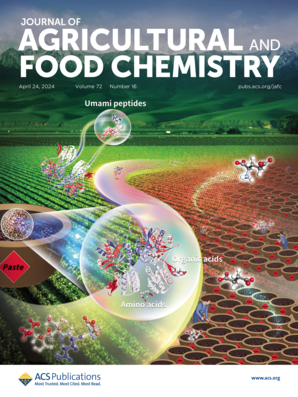基于硅基反向注释和分子网络的生姜酚类化合物的鉴定与分离
IF 5.7
1区 农林科学
Q1 AGRICULTURE, MULTIDISCIPLINARY
引用次数: 0
摘要
生姜含有丰富的生姜酚类物质,具有抗炎作用。抗神经炎症途径是一种很有前途的治疗神经退行性疾病的策略。选择生姜作为我们的研究对象,以发现具有抗神经炎症作用的生物活性成分。采用基于硅的反向注释策略,结合分子网络,对姜酚进行了大规模注释。共标记了174种姜酚和235种姜酚二聚体。采用该方法分离得到5个新的生姜酚类化合物(1 - 5)和18个已知的生姜酚类化合物(6-23),其中化合物1为新的天然产物,化合物2-3为新的生姜酚二聚体。它们的结构通过广泛的光谱数据和半合成方法得以阐明。化合物2、8、12、18和19在10、20和40 μM浓度的脂多糖(LPS)诱导的BV2细胞中表现出抑制一氧化氮(NO)产生的能力,并显示出抗神经炎症活性。酶联免疫吸附试验(ELISA)显示,化合物2、18和19可显著降低环氧化酶-2 (COX-2)和白细胞介素-1β (IL-1β)的表达水平。此外,化合物2和18对白细胞介素-10 (IL-10)和白细胞介素-6 (IL-6)的表达有一定的抑制作用。Western blot分析显示,化合物18和19能有效抑制IL-1β的表达,而化合物2能抑制磷酸化核因子κB (p-NF-κB)在BV2细胞中的表达。本研究表明,该策略在生姜资源利用中具有巨大的潜力和前景。此外,生姜还含有多种具有抗神经炎症活性的姜酚类物质。本文章由计算机程序翻译,如有差异,请以英文原文为准。

Characterization and Isolation of Ginger Phenols from Zingiber officinale Rhizomes through in Silico-Based Reverse Annotation and Molecular Networking
Ginger is a rich source of ginger phenols with an anti-inflammatory property. Antineuroinflammatory pathways represent a promising therapeutic strategy for neurodegenerative diseases. Ginger was selected as our research object to discover bioactive constituents responsible for the antineuroinflammatory effect. An in silico-based reverse annotation strategy, in conjunction with molecular networking, was employed for the large-scale annotation of ginger phenols from ginger. A total of 174 ginger phenols and 235 ginger phenol dimers were annotated. Five new ginger phenols (1–5) and 18 known ginger phenols (6–23) were isolated following this proposed strategy, among which compound 1 was a new natural product and compounds 2–3 were novel ginger phenol dimers. Their structures were elucidated using extensive spectroscopic data and semisynthesis methods. Compounds 2, 8, 12, 18, and 19 exhibited a capacity to inhibit nitric oxide (NO) production and demonstrated antineuroinflammatory activity in lipopolysaccharide (LPS)-induced BV2 cells at the concentrations of 10, 20, and 40 μM. Enzyme-linked immunosorbent assay (ELISA) showed that compounds 2, 18, and 19 could significantly reduce the expression levels of cyclooxygenase-2 (COX-2) and interleukin-1β (IL-1β). In addition, compounds 2 and 18 displayed a certain inhibitory effect on the expressions of interleukin-10 (IL-10) and interleukin-6 (IL-6). The Western blot analysis revealed that compounds 18 and 19 effectively attenuated the expression of IL-1β, while only compound 2 inhibited the expression of phosphorylated nuclear factor kappa B (p-NF-κB) in BV2 cells. This study demonstrates the great potential and prospect of the proposed strategy in the utilization of ginger resources. Additionally, it reveals that ginger contains diverse ginger phenols with antineuroinflammation activity.
求助全文
通过发布文献求助,成功后即可免费获取论文全文。
去求助
来源期刊
CiteScore
9.90
自引率
8.20%
发文量
1375
审稿时长
2.3 months
期刊介绍:
The Journal of Agricultural and Food Chemistry publishes high-quality, cutting edge original research representing complete studies and research advances dealing with the chemistry and biochemistry of agriculture and food. The Journal also encourages papers with chemistry and/or biochemistry as a major component combined with biological/sensory/nutritional/toxicological evaluation related to agriculture and/or food.

 求助内容:
求助内容: 应助结果提醒方式:
应助结果提醒方式:


